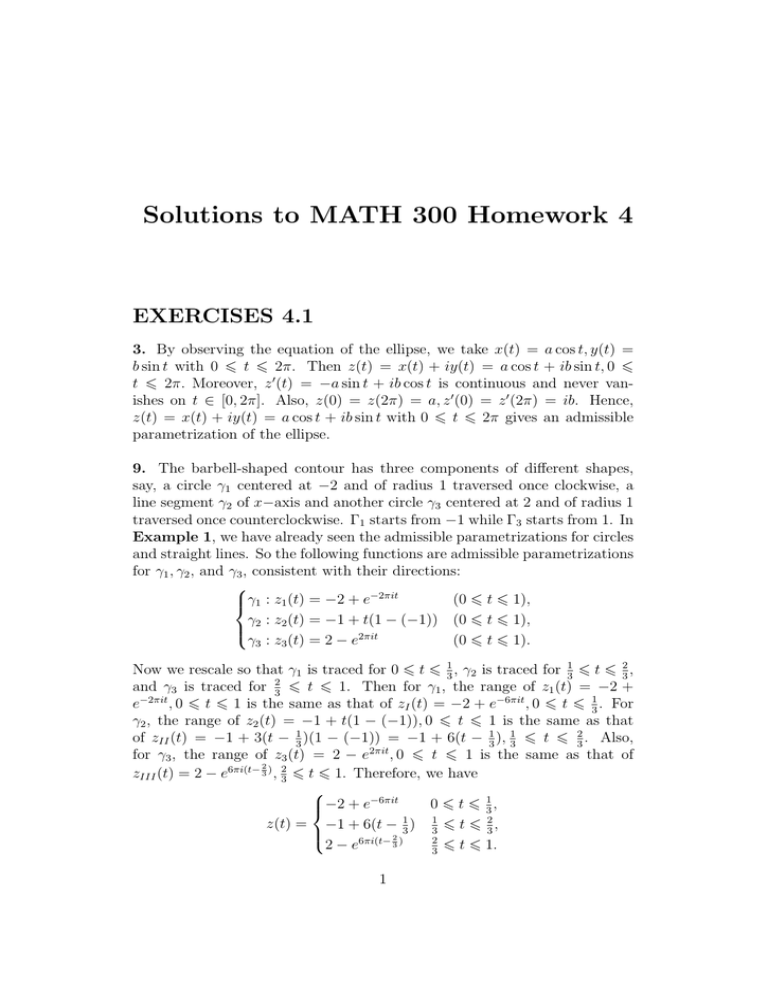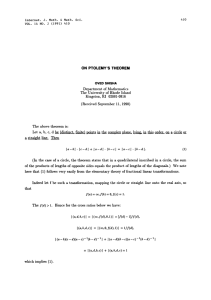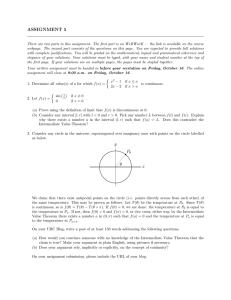Solutions to MATH 300 Homework 4 EXERCISES 4.1
advertisement

Solutions to MATH 300 Homework 4
EXERCISES 4.1
3. By observing the equation of the ellipse, we take x(t) = a cos t, y(t) =
b sin t with 0 6 t 6 2π. Then z(t) = x(t) + iy(t) = a cos t + ib sin t, 0 6
t 6 2π. Moreover, z 0 (t) = −a sin t + ib cos t is continuous and never vanishes on t ∈ [0, 2π]. Also, z(0) = z(2π) = a, z 0 (0) = z 0 (2π) = ib. Hence,
z(t) = x(t) + iy(t) = a cos t + ib sin t with 0 6 t 6 2π gives an admissible
parametrization of the ellipse.
9. The barbell-shaped contour has three components of different shapes,
say, a circle γ1 centered at −2 and of radius 1 traversed once clockwise, a
line segment γ2 of x−axis and another circle γ3 centered at 2 and of radius 1
traversed once counterclockwise. Γ1 starts from −1 while Γ3 starts from 1. In
Example 1, we have already seen the admissible parametrizations for circles
and straight lines. So the following functions are admissible parametrizations
for γ1 , γ2 , and γ3 , consistent with their directions:
−2πit
(0 6 t 6 1),
γ1 : z1 (t) = −2 + e
γ2 : z2 (t) = −1 + t(1 − (−1)) (0 6 t 6 1),
γ3 : z3 (t) = 2 − e2πit
(0 6 t 6 1).
Now we rescale so that γ1 is traced for 0 6 t 6 13 , γ2 is traced for 13 6 t 6 23 ,
and γ3 is traced for 32 6 t 6 1. Then for γ1 , the range of z1 (t) = −2 +
e−2πit , 0 6 t 6 1 is the same as that of zI (t) = −2 + e−6πit , 0 6 t 6 13 . For
γ2 , the range of z2 (t) = −1 + t(1 − (−1)), 0 6 t 6 1 is the same as that
of zII (t) = −1 + 3(t − 13 )(1 − (−1)) = −1 + 6(t − 13 ), 13 6 t 6 23 . Also,
for γ3 , the range of z3 (t) = 2 − e2πit , 0 6 t 6 1 is the same as that of
2
zIII (t) = 2 − e6πi(t− 3 ) , 23 6 t 6 1. Therefore, we have
−6πit
0 6 t 6 31 ,
−2 + e
z(t) = −1 + 6(t − 13 ) 13 6 t 6 23 ,
2
2
6 t 6 1.
2 − e6πi(t− 3 )
3
1
11. The function z = z(t) = 5e3it parametrizes a circle centered at the
origin and of radius 5. The circle is traversed one and a half times counterclockwise. The starting point returns to itself, which is (5, 0) after time
t = 2π/3. And then it starts moving around again for time t = π/3, which
is a half of the period 2π/3. So the length of the contour is one and a half of
3
its perimeter, i.e., l(Γ) = · 2π · 5 = 15π. Or directly compute the integral
2
ˆ π
ˆ π
3it
|15ie | dt =
15 dt = 15π.
expression of the length `(Γ) =
0
0
EXERCISES 4.2
3.(b)
ˆ
2
t
dt
+ i)2
0
ˆ 2
1
=
d(t2 + i)
2
2
0 (t + i)
2
1
1
=−
2
2
2 (t + i) (t2
0
−2 − 8i
.
=
17
5. From Example 2 we know
ˆ
(
0
for n 6= −1,
(z − z0 )n dz =
2πi for n = −1,
Cr
where Cr = {z ∈ C : |z − z0 | = r}. Then for C = {z ∈ C : |z − i| = 4} traversed once counterclockwise,
ˆ 6
2
2
+
+ 1 − 3(z − i) dz
2
z−i
C (z − i)
ˆ
ˆ
ˆ
ˆ
1
1
dz + 2
dz +
1dz − 3 (z − i)2 dz
=6
2
(z
−
i)
z
−
i
C
C
C
C
= 0 + 2 · 2πi + 0 − 0
= 4πi.
2
10. According to Definition 4 we have
ˆ
ˆ
ˆ
ˆ
2
2
2
z̄ dz =
z̄ dz +
z̄ dz +
C
C1
C2
ˆ
2
z̄ 2 dz,
z̄ dz +
C3
C4
where Ci , i = 1, 2, 3, 4 can be parametrized as
C1
C2
C3
C4
: z1 (t) = t
: z2 (t) = 1 + it
: z3 (t) = i + 1 − t
: z4 (t) = i(1 − t)
By Theorem 4 we have
ˆ
ˆ
(0 6 t 6 1),
(0 6 t 6 1),
(0 6 t 6 1),
(0 6 t 6 1).
1
2
z1 (t) z10 (t) dt
0
1
ˆ 1
t3 1
2
t dt = = ,
=
3 0 3
0
2
z̄ dz =
C1
ˆ
ˆ
1
2
z2 (t) z20 (t) dt
2
z̄ dz =
C2
0
ˆ
1
(1 − it)2 i dt
0
1
it3
2i
2
+t =1+ ,
= it −
3
3
0
=
ˆ
ˆ
1
z̄ dz =
C3
2
z3 (t) z30 (t) dt
2
0
ˆ
1
−(1 − t − i)2 dt
=
0
1
t3
2
2
2
= − + t − it + 2it = + i,
3
3
0
ˆ
ˆ
1
z̄ dz =
C4
2
z4 (t) z40 (t) dt
2
0
ˆ
1
−(t − 1)2 (−i) dt
0
1
t3
i
2
= i − it + it = ,
3
3
0
=
3
Therefore
ˆ
z̄ 2 dz =
C
2i 2
i
1
+ 1 + + + i + = 2 + 2i.
3
3
3
3
1
12. Since on the unit circle |z| = 1, z z̄ = 1, it follows that z̄ = . Therefore,
z
the two integrals are equal.
14. (c) On the arc of the unit circle lying in the first quadrant,
|Log z| 6 |Log 1 + iArg z| 6 π/2.
On the other hand, the length of the arc is 41 · 2π · 1 = π/2. Hence, by
Theorem 5,
ˆ
2
Log z dz 6 π .
4
Γ
EXERCISE 4.3
1. (b) Since the integrand has the antiderivative F (z) = ez for all z. By
Theorem 6, we have
−1
ˆ
z
z
e dz = e = e−1 − e = −2 sinh 1.
Γ
1
(g) The principal branch of z α is the same as that of Log z, C \ (−∞, 0].
By the discussion on p.133, we know that z α has derivative αz α z1 on each
branch, including the principal branch. Thus, using Theorem 6, we can
directly compute the integral.
√
√
i
ˆ
2 3πi 2 3
2 2 √ 3 i 2
2 3 1/2
− ( π) +
.
z dz = z 2 = e 4 − π 2 = −
3 π 3
3
3
3
3
Γ
(h) Since (Log z)2 is analytic on C \ (−∞, 0], we can directly compute the
integral.
i
ˆ
π2
2
2
(Log z) dz = z(Log z) −2zLog z+2z = i(Log i)2 −2i Log i+2i−2 = π−2+i(2− ).
4
Γ
1
Pn
i
2. Let the polynomial be of the form P (z) =
i=0 ai z . Then P (z) is
continuous and has an antiderivative throughout C containing Γ. That is,
n
X
ai i+1
P(z) =
z .
i+1
i=0
4
Then by Corollary 2
ˆ
P (z) dz = 0.
Γ
4. False. Let Γ be the unit circle |z| = 1 and 1/z the function. We know
that 1/z is analytic at each point of the unit circle, but the integral
ffi
1
dz = 2πi.
|z|=1 z
5.
´ By Theorem
´ 7, f (z) = 1/z has antiderivative in C \ {0} if and only if
f (z) dz = Γ2 f (z) dz, where Γ1 and Γ2 are any two contours in C \ {0}
Γ1
sharing the same initial and terminal points. But Example 2 shows that
for the two contours the integrals are not equal.
12. Let the contour Γ be the line segment from z1 to z2 . Then by Theorem 5 in Sec. 4.2,
ˆ
0
|f (z1 ) − f (z2 )| = f (z) dz 6 M |z2 − z1 |.
Γ
Exercise 4.4
3. (a), (b), (d), (e). For (a), (b), (d), it is easy to observe that they are
continuously deformable to Γ in D (by first deformed into a point, then to
Γ). For (e), the deformation function will be
z(s, t) = 3 + e(2−6s)πit ,
where 0 6 s 6 1, 0 6 t 6 1. For (c), it is impossible to continuously deform
it to Γ, since any deformation will pass through the unit disk |z| 6 1, which
is not contained in D.
4. We construct Γ0 first. The unit circle can be parametrized by
(
e4πit
0 6 t 6 1/2,
z(t) =
4πi(1−t)
e
1/2 6 t 6 1.
Also, the point can be simply written as e2πi(0) . Then we have
(
e4πi(1−s)t
(0 6 t 6 1/2),
z(s, t) =
4πi(1−s)(1−t)
e
(1/2 6 t 6 1),
5
where 0 6 s 6 1. It is immediate to verify that
ˆ
ffi
fi
f (z) dz =
f (z) dz +
f (z) dz
Γ0
|z|=1
|z|=1
ffi
ffi
ˆ
=
f (z) dz −
f (z) dz = 0 =
|z|=1
|z|=1
f (z) dz.
z=1
ˆ
15. Since Γ is the circle |z| = 4 traversed twice counterclockwise,
2 · (−2πi) for |a| 6 4. Therefore,
ˆ
ˆ
ˆ
z
1
2
1
1
dz =
dt +
dz
3 Γ z−1
3 Γ z+2
Γ (z + 2)(z − 1)
2
1
= (−4πi) + (−4πi)
3
3
= −4πi.
Γ
1
dz =
z−a
18. (a) For all R > 2, the circle |z| = 2 can be continuously deformed into
1
|z| = R. Then by Theorem 8, for f (z) := 2
we have
z (z − 1)3
ffi
ffi
I(R) =
f (z) dz =
f (z) dz = I.
|z|=R
|z|=2
(b) By Theorem 5 in Sec. 4.2,
ffi
|I(R)| = |z|=R
6
1
dz
z 2 (z − 1)3 1
|z|2 (|z|
− 1)3
`(|z| = R)
1
2πR
R2 (R − 1)3
2π
=
.
R(R − 1)3
=
(c) It is evident that
2π
= 0.
R→+∞ R(R − 1)3
lim
Then lim I(R) = 0.
R→+∞
(d) As R → +∞, the circle |z| = 2 can also be continuously deformed
into |z| = R. Therefore, I = lim I(R) = 0.
R→+∞
6

